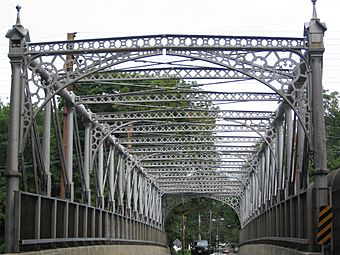Riverside Avenue Bridge (Greenwich, Connecticut) facts for kids
Quick facts for kids |
|
|
Riverside Avenue Bridge
|
|

Riverside Avenue Bridge, looking north
|
|
| Location | Riverside Ave. and RR tracks, Greenwich, Connecticut |
|---|---|
| Area | 0.1 acres (0.040 ha) |
| Built | 1871 |
| Architect | Francis C. Lowthrop; Keystone Bridge Co. |
| Architectural style | Pratt truss |
| NRHP reference No. | 77001391 |
| Added to NRHP | August 29, 1977 |
The Riverside Avenue Bridge is a very special bridge in Connecticut. It's the only one made of cast-iron in the whole state! It's also one of just a few cast-iron bridges still used in the United States. This bridge carries Riverside Avenue over the train tracks in Riverside, a part of Greenwich, Connecticut.
This bridge has an interesting story. It was first built in 1871 as part of a much larger bridge over the Housatonic River. When that big bridge was replaced, a section of it was moved and rebuilt here in Riverside in 1895. Because it's so unique and important, the bridge was added to the National Register of Historic Places in 1977. Experts call it a "major engineering landmark."
Contents
The Bridge's Journey
The Riverside Avenue Bridge wasn't always in Riverside. It started as part of a six-span railroad bridge. This original bridge was built in 1871 over the Housatonic River in Stratford, Connecticut. The Keystone Bridge Company from Pittsburgh, Pennsylvania built it.
An engineer named F. C. Lowthorp designed the original structure. The New York and New Haven Railroad used this bridge. Later, in 1884, the railroad replaced the big river bridge. But they didn't throw away all the parts!
Moving to Riverside
Eleven years later, in 1895, one section of the old bridge was moved. It was rebuilt in Riverside, right next to the Riverside train station. This is how the Riverside Avenue Bridge came to be.
The bridge uses a design called a double-intersection Pratt truss. It's made from a mix of cast-iron and wrought-iron parts. It also has fancy decorations. When it was built, people thought it was both beautiful and strong.
Why Cast-Iron Bridges Changed
Over time, trains became much heavier. Engineers also learned more about the weaknesses of cast-iron bridges. Because of this, many cast-iron bridges were replaced with stronger ones. The Riverside Avenue Bridge is special because it's one of the few from that time that still exists.
On September 29, 1977, the bridge was officially added to the National Register of Historic Places. This means it's recognized as an important historical site.
Keeping the Bridge Safe
By 1986, people started to worry about the bridge's safety. There were vibrations and some rust on the metal parts. Traffic officials and local residents became concerned.
Engineers couldn't find the original building plans for the bridge. So, they used special tools like ultrasonics to check how strong the bridge was. These tests showed that the bridge needed repairs to be safe.
A Clever Repair Idea
The engineers came up with a very smart plan. They wanted to keep the bridge's unique old look. But they also needed it to be strong enough for modern traffic. Their solution was to build a new bridge inside the old one!
They replaced the old wooden road surface with a new concrete structure. This new concrete part was designed to carry all the weight of cars and trucks. They carefully cut notches in the steel beams of the old bridge. This allowed the new concrete deck to be thick and strong.
The new design made the bridge safe without changing its original appearance too much. The old metal structure now only carries its own weight. The new concrete deck carries all the traffic.
The Repair Project
The big repair project started in August 1988. It cost about $2.7 million. Workers used cranes to carefully put the new bridge parts into place. They also cleaned and painted the entire bridge.
The way the bridge was repaired was very clever. It allowed this historic bridge to keep serving the community safely.



